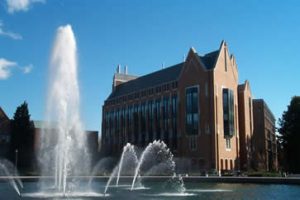Leads: Morteza Mehrnoush, Vanlin Sathya
LTE-LAA and Wi-Fi Coexistence:
With both small-cell LTE and 802.11 networks available as alternatives for deployment in unlicensed bands (notably 5 GHz), the investigation into their coexistence is a topic of active interest, primarily driven by industry groups. Notably, 3GPP has standardized LTE Licensed Assisted Access (LAA) that seeks to make LTE more co-existence friendly with Wi-Fi by incorporating similar sensing and back-off features. Nonetheless, the results presented by industry groups offer little consensus on important issues like respective network parameter settings that promote “fair access” as required by 3GPP. Answers to such key system deployment aspects, in turn, require credible analytical models, on which there has been little progress to date. Accordingly, in this project, we develop a new framework for estimating the throughput of WiFi and LTE-LAA in coexistence scenarios via suitable modifications to the celebrated Bianchi model. Also, the fairness of this coexistence network based on 3GPP definition of fairness and proportional fairness is investigated. The proposed model is corroborated via a National Instrument (NI) Labview based experimental testbed (as indicated in Figure 1) that validates the results for LTE-LAA access priority class 1 and 3. More information on ns-3 (network simulator) module for Wi-Fi and LTE-LAA coexistence can be found here.

Figure 1. Coexistence of Wi-Fi and LTE-LAA
Association fairness in Wi-Fi and LTE-U Coexistence:
The issue of association fairness is a great challenge when Wi-Fi and LTE unlicensed (LTE-U) coexist on the same channel in the unlicensed 5 GHz band. Since beacon transmission is the first step in starting the association process in Wi-Fi, we define association fairness as how fair LTE-U is in allowing Wi-Fi to start transmitting beacons on a channel that it occupies with a very large duty cycle. According to the LTE-U specification, if a LTE-U base station determines that a channel is vacant, it can transmit for up to 20 ms and turn OFF for only 1 ms, resulting in a duty cycle of 95%. In an area with heavy spectrum usage, there will be cases when a Wi-Fi access point wishes to share the same channel, as it does today with Wi-Fi. In this project, we study, both theoretically and experimentally, the effect that such a large LTE-U duty cycle can have on the association process, specifically Wi-Fi beacon transmission and reception. We demonstrate via an experimental set-up using National Instrument (NI) USRPs (as shown in Figure 2) that a significant percentage of Wi-Fi beacons will either not be transmitted in a timely fashion or will not be received at the LTE-U BS thus making it difficult for the LTE-U BS to adapt its duty cycle in response to the Wi-Fi usage. Our experimental results corroborate our theoretical analysis. We compare the results with Wi-Fi/Wi-Fi coexistence and demonstrate that LTE-U/Wi-Fi coexistence is not fair when it comes to initial association since there is a much larger percentage of beacon errors in the latter case. Hence, the results in the project indicate that in order to maintain association fairness, a LTE-U BS should not transmit at such high duty cycles, even if it deems the channel to be vacant.

Figure 2: LTE Wi-Fi Co-existence Experimental Setup.
Impact of changing energy detection thresholds on fair coexistence of Wi-Fi and LTE in the Unlicensed Spectrum:
As per the IEEE 802.11 standard, Wi-Fi uses an energy detection (ED) threshold of -62 dBm when Long Term Evolution-Licensed Assisted Access (LTE-LAA) and/or Long Term Evolution Un-Licensed (LTE-U) nodes are deployed close by, whereas the LTE-LAA specification recommends that LTE-LAA detect Wi-Fi at -72 dBm. Figure 3a shows both Cell A and Cell B using Wi-Fi, where the users associated with Cell A and Cell B are denoted by red and blue respectively. Figure 3b shows Cell A switching to LTE-LAA and Figure 3c shows Cell A switching to LTE-U. In this project, we evaluate varying ED thresholds in these three scenarios thoroughly. We develop a coexistence simulator in ns-3 and vary both the Wi-Fi and LTE energy detection thresholds and demonstrate that lowering the Wi-Fi ED threshold from -62 dBm improves performance for both Wi-Fi and LTE-LAA. Prior work has mostly focused on determining the ED threshold that should be used by LTE-LAA/LTE-U. As far as we are aware, this is the first result that demonstrates that lowering the Wi-Fi ED threshold improves performance for both systems. The conclusion is that if Wi-Fi treats LTE-LAA/LTE-U as it would an overlapping Wi-Fi, coexistence performance improves compared to the current assumption that Wi-Fi treats LTE-LAA/LTE-U as noise.

Figure 3: (a) Cell A and Cell B use Wi-Fi, (b) Cell A switches to LTE-LAA and (c) Cell A switches to LTE-U
Publication:
- M. Mehrnoush, V. Sathya, S. Roy and M. Ghosh, “Analytical Modeling of Wi-Fi and LTE-LAA Coexistence: Throughput, and Impact of Energy Detect Threshold,” IEEE Transactions on Networking (Under Review)
- Vanlin Sathya, Morteza Mehrnoush, Monisha Ghosh, and Sumit Roy, “ Association fairness in Wi-Fi and LTE-U Coexistence”, IEEE Wireless Communications and Networking Conference (WCNC). (Under Review)
- Muhammed Iqbal Cholilur Rochman, Vanlin Sathya, and Monisha Ghosh, “Impact of changing energy detection thresholds on fair coexistence of Wi-Fi and LTE in the unlicensed spectrum”, IEEE Wireless Telecommunication Symposium (WTS), April 2017, Chicago, USA. Link: http://ieeexplore.ieee.org/abstract/document/7943527/

